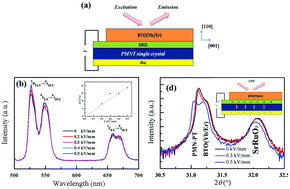In situ reversible tuning of photoluminescence of an epitaxial thin film via piezoelectric strain induced by a Pb(Mg1/3Nb2/3)O3–PbTiO3 single crystal†
Abstract
Conventionally, photoluminescence (PL) properties are mainly modulated through traditional chemical approaches which are ex situ, irreversible and static modulation techniques, potentially limiting the understanding of the detailed process of luminescence and smart PL applications. Here, an in situ dynamic routine is developed to tune the PL response in an epitaxial Yb3+/Er3+ co-doped BaTiO3 thin film through electric-field-induced strain of a piezoelectric single-crystal Pb(Mg1/3Nb2/3)O3–PbTiO3 (PMN–PT) substrate. A reversible tuning and enhancement of the PL intensity was achieved when an external electric field was applied to the PMN–PT single-crystal substrate. The underlying mechanism responsible for the dynamic enhancement of the PL intensity was attributed to the strain induced lower host symmetry so as to enhance the hypersensitive transition probability of the rare-earth ions. The present work could provide a significant guide for the in situ dynamic and active modulation of the PL performances of luminescent devices through the piezoelectric strain.



 Please wait while we load your content...
Please wait while we load your content...